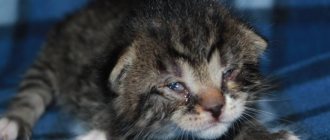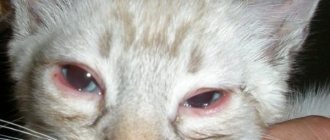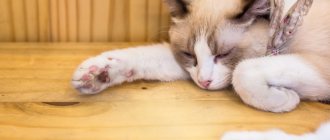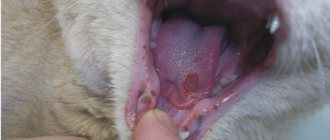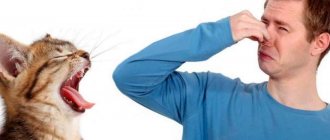February 8, 2018
Crying while watching a melodrama is quite normal for a person. But if a cat starts crying, then you need to start sounding the alarm and take a close look at his well-being! If your cat's eyes are watery, you should pay attention to the state of its health.
Of course, veterinarians note the fact that by nature, cats' eyes can water from time to time. For example, in kittens under the age of one year, this occurs in 70% of cases. However, any responsible owner of even an adult cat should periodically carefully examine the eyes of their pet.
Why do cats have watery eyes: causes and symptoms
What kind of discharge from a cat's eyes can be considered normal? Veterinarians are unanimous on this issue: minor discharge that accumulates in the corners of the eyes is absolutely normal. They represent a physiological norm. It is enough to remove them regularly. To do this, you can use cotton swabs, after moistening them with water, or cotton pads. You can purchase specialized eye drops.
There’s no need to guess about the reason why a cat’s eyes are watery either. In the case when the baby was torn away from his mother at a very early age, the baby’s eyes may turn sour due to a banal inability to take care of himself. He just didn't have time to learn it. As the pet grows, it will gradually acquire this skill and begin to independently care for its face, wash it like an adult cat and carry out other hygiene procedures.
However, if the owner notices that the cat periodically rubs its eyes with its paws, he should be wary. This is a direct signal that something is wrong. The main task for the owner is now to take his pet to the veterinarian as soon as possible.
A prerequisite is to visit a cat doctor with your pet, since in this matter an examination of the animal is simply necessary. There are many reasons for excessive lacrimation, which means that no conscientious veterinarian would take on the responsibility of prescribing treatment in absentia.
The main diagnosis, which is most often made by a doctor, for such symptoms is inflammation of the conjunctiva and, in other words, conjunctivitis. However, you should not relax from some familiarity of the diagnosis. This disease looks harmless only at first glance. As a rule, its causes often include a list of viral, bacterial, invasive and other diseases.
What are the main causes of watery eyes in cats?
There are many reasons why a cat's eyes become watery. Among them there are both quite harmless and dangerous eye diseases.
1. Missed vaccination.
If the baby's eyes begin to water often and a lot, the owner needs to think about whether he missed the time for vaccination? The fact is that kittens have not yet fully developed immunity and infections or viruses that enter their body can manifest themselves in a similar way, in the form of teary eyes.
2. Features of the breed.
Some cat breeds have slightly rolled-up eyelids as a characteristic feature, which can cause small cracks in the skin. The dirt that gets into them can cause the development of conjunctivitis.
There is an opinion that entropion (the phenomenon of a rolled eyelid) can occur in absolutely any cat. However, in practice, in outbred cats, this occurs in isolated cases. But in British cats, Maine Coons, Sphynxes, Persian cats, Scottish fold kittens, a rolled eyelid is quite common. Unfortunately, in such a case, only surgical intervention will help overcome the phenomenon of tearing of the eyes.
3.Allergy.
Watery eyes may be a symptom of an allergy. Its main causes and irritants can be: the pungent smell of chemicals, aerosol, deodorant, which the owner is used to using daily while at home. They can become a direct cause of the appearance of such eye pathology. An allergic reaction can also develop from a pet’s consumption of certain foods. Allergies can also be caused by poplar blossoms, namely its fluff, plant pollen, and cosmetics. In the case of food allergies, this problem is solved by simply eliminating the allergen from the animal’s diet. In other cases, only hormonal medications carefully selected by a veterinarian will help get rid of it.
Virus.
Viral, bacterial or fungal disease, namely the manifestation of mycoplasmosis, calcivirosis, herpesvirosis, toxoplasmosis, chlamydia, etc. Tearfulness of the eyes is a direct symptom of the listed (and not only) diseases, and therefore only a good veterinarian.
Inflamed cornea of the eyes.
In the case when the eyes are watery and at the same time covered with a film, then such a symptom may well be a symptom of an inflamed cornea, in other words, keratitis.
Cataract.
If the lens is smoky or white, then this is direct evidence of cataracts.
Increased main pressure.
Tearfulness can cause increased eye pressure in a cat. In addition to the appearance of discharge from the eyes, the appearance of increased eye pressure can lead to blindness of the pet.
Blockage of tear ducts.
Clogged tear ducts from birth or acquired during the animal's life are another reason why a cat's eyes may become watery.
Parasites.
If the owner notices that one of the cat’s eyes is watering, this may give him a signal that he needs to remember the last time he dewormed his pet. Timely extermination of parasites in the animal’s body can stop the disease in time and prevent it from developing into a more severe form.
Cold.
If the cat began to rub his watery eyes and sneeze, then he could simply have a cold, like a person.
Eye injury.
Of course, we cannot discount the possibility of simple eye injuries. However, there is one caveat here. In such cases, as a rule, the eye that was injured more is more watery.
Based on all of the above, it is necessary to recall once again that the true cause can only be determined by a veterinarian after examining the animal.
Prevention of eye diseases
*Prices are current as of September 2021.
Canadian Sphynx
There are cat breeds that are susceptible to increased tearing, which can lead to inflammation. Inflammatory eye diseases most often occur in Sphynx cats. Due to the inversion of the eyelids, these animals often develop chronic conjunctivitis. In addition to the Sphynx, this group includes the Scottish Fold and the British. In the Scots and British, increased tear production is due to the structural features of the muzzle - a narrowing in the area of the bridge of the nose.
Maine Coons, Persians and Exotics also often suffer from inflammatory eye pathologies. If you do not take care of the eyes of such pets, tears flowing down the fur can cause inflammatory dermatological pathologies.
Why do my cat's eyes turn sour?
If in the case of a kitten’s slightly tearful eyes, the problem can resolve itself, then souring of the eyes is a very bad symptom, which indicates that the disease that caused it is beginning to develop into a more severe form.
A cat’s eyes fester both for a number of reasons that were mentioned earlier, and for such serious diseases as, for example, feline distemper. The appearance of purulent discharge, in itself, is a direct clue as to which direction to look for the problem.
If they are transparent and watery, the cause may be an allergic animal.
If the discharge is brown, yellow or green, and at the same time has a thick consistency, the animal’s eyelids stick together, then this is a direct sign of the presence of an infectious disease.
When visiting a veterinary clinic, a cat whose eyes are sour will be washed from the conjunctiva and a series of clinical tests will be carried out to determine the causative agent. Upon completion of these studies, a diagnosis will be made and recommendations for further treatment of the pet will be given.
You should visit a veterinarian if you have the following symptoms:
- red eyes on a cat;
- swollen eyelids;
- changed color of the fur around the eyes;
- photophobia;
- lack of appetite;
- cat lethargy;
- whitened lens of the eye;
- film on the eyeballs.
Treatment
When deciding what to do if a kitten’s eyes turn sour, you need to keep in mind that independent treatment is advisable when you are confident that there is no infectious or viral disease. In this case, positive dynamics should be observed. If after 3-4 days of therapy the animal’s condition does not improve or becomes worse, you should contact a veterinarian.
Before examination by a specialist, you can wash your kitten’s sour eyes with Bars. The product can be used for injuries, as therapy and prevention of conjunctivitis, blepharitis, keratitis.
Dark brown crusts in the corners of the eyes after sleep indicate infection with parasites. You can eliminate the problem by giving the kitten a “Parasicide” suspension. Additionally, it is necessary to rinse the eyes with drinking tea or chamomile infusion. During treatment, watch your baby's toilet and how he eats.
How to wipe a kitten's eyes?
It would be most optimal to choose calendula, St. John's wort, chamomile and sage for such a procedure. They will help you easily remove accumulations of minor discharge from your kitten’s eyes.
If necessary, you can wash your cat's eyes by:
- homemade herbal tincture (chamomile);
- furatsilin solution (1:5000);
- boric acid solution (2%).
Eye drops for daily care
- Leopard;
- Diamond eyes.
In cases where the manifestation of tearing has become pathological, veterinarians often prescribe eye drops for bacterial conjunctivitis:
- chloramphenicol;
- kanamycin;
- sodium sulfate;
- Sofradox.
In a number of individual cases, ointment containing antibiotics and eye films help quite well.
Manifestations of allergic tearing should disappear upon completion of the hormonal course of treatment.
If the infection is caused by a virus, then only a veterinarian can advise its treatment.
What to choose for processing?
Antibacterial agents are selected for treatment, for example, a solution of furatsilin along with boric acid or special drops from any pet store. Under no circumstances should you use an alcohol solution, even a very diluted one with water. This not only provokes a new wave of pathological discharge, but can also damage the inflamed eye. You can prepare the medicinal composition yourself:
- Preparation of saline solution. Add a spoonful of salt to a liter of boiled water. Stir everything thoroughly and boil the resulting liquid. Before treating the eyes, the liquid is cooled to body temperature; it should not burn the skin. This solution can be used for any type of discharge, with the exception of allergic reactions. How to cure a kitten's eyes? We continue to consider this issue.
- Using a weak infusion of a medicinal plant. To prepare it, take two tablespoons of sage, pour boiling water over it (it is best to use distilled water) and keep the product in a water bath for 15 minutes. After this, everything is filtered through gauze, and the same thing is done a second time through cotton wool, then the product is diluted with water to obtain 500 ml of liquid. The medicine should be stored in the refrigerator, but not more than one day. This weak infusion is also used when allergies occur.
- Weak black tea is also suitable for rinsing. The caffeine it contains can have an anti-inflammatory effect and relieve the kitten's condition.
We suggest you read: What to feed a cat with kidney failure: food and diet
So, kittens’ eyes are festering, what should you do? The eyes need to be washed, as described below.
How to wipe and rinse a cat's eyes
When the doctor has already prescribed treatment for the cat’s eyes and the procedures are carried out at home, it will not be a bad idea to read the short instructions.
You need to prepare:
- several gauze napkins/cotton pads;
- pipette/disposable syringe;
- towel;
- delicacy!
Action 1.
It is necessary to catch and secure the pet, wrap it in a towel. If the procedure is being carried out for the first time, then it would be quite appropriate to invite other family members to provide assistance, since the animal in panic may begin to break out with a force that the owner had no idea about before. The presence of a towel is necessary so that a desperately resisting cat does not injure its owner. As a rule, pets do not really like various kinds of manipulations.
Action 2.
A number of necessary manipulations should begin. A napkin or cotton pad should be soaked in the medicinal solution, soak the crusts and remove them.
Action 3.
You need to take a new cotton pad or napkin and soak it in the medicinal solution. Using your thumb and index finger, separate your eyelids and rinse them, moving from the outer corner of the eye to the inner. You need to try to wet the conjunctiva generously with the solution. If you have sufficient experience, the rinsing procedure can be carried out using a disposable syringe (without a needle), injecting the solution directly under the eyelids.
Action 4.
You need to blot your pet's eyes with a dry and clean napkin or cotton pad.
Action 5.
Next, you should appease your pet with his favorite treat. Surely, performing these procedures became stressful for him. If the animal is very offended, you can add a double portion of treats.
In conclusion, it must be said that regular eye hygiene, fur care, teeth cleaning, manicure/pedicure should become a number of familiar procedures for your pet fluffy.
Tags: Health, Treatment, Veterinarians' opinion, Disease prevention
Treatment of conjunctivitis
After making sure that sour eyes do not indicate the development of a viral or infectious disease, you need to help your pet cope with the inconvenience. Please note that self-treatment is acceptable if it helps, that is, you clearly observe positive dynamics. If your cat gets worse or does not see noticeable improvement within 3-4 days, contact your doctor. The absence of positive dynamics indicates that the regimen you have chosen does not destroy the causative agent of conjunctivitis.
When contacting a doctor, the type of pathogen is diagnosed, namely, washing off from the mucous membranes of the eyes. After examining the purulent discharge, it becomes clear what type of microorganism caused the disease. Identifying the exact cause makes it possible to treat with narrow-spectrum drugs that do not have a short list of side effects.
Without a laboratory examination, the doctor will prescribe treatment with broad-spectrum drugs. Typically, drops are selected that will kill the majority of common microorganisms in a short time. If treatment does not give positive dynamics on days 2-3, the cat is examined more thoroughly to identify the root cause.
The traditional treatment algorithm is to maintain maximum cleanliness, eliminate reporting and irritation, and use eye drops. To keep the eyelids clean, your cat's eyes should be wiped with tea, freshly brewed chamomile or calendula. Prices for drops vary greatly; for example, broad-spectrum drugs can differ in cost by 10 times or more.
The difference is noticeable in the speed of action, for example, using chloramphenicol drops, you will treat a cat for 3-4 days, the same ciprovet will remove all symptoms in 1-2 days. However, there is not much difference here either, since the minimum period of treatment, 5–7 days, must be carried out without fail, even if the symptoms have completely disappeared.
Important! If your pet is prone to allergies or belongs to breeds with a short muzzle, be sure to consult a doctor before starting medication treatment.

